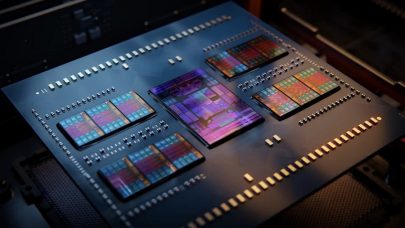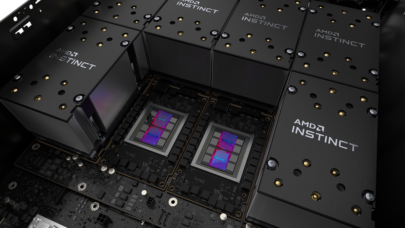
Scientific Computing Options Maturing in the Cloud
August 31, 2023
Supercomputing remains largely an on-premises affair for many reasons that include horsepower, security, and system management. Companies need more time to move Read more…

How AMD Used Its Chiplet Advantage to Design MI300X GPU and Bergamo CPU
June 14, 2023
Swap out a few silicon parts, and voila, you have a spanking new chip that did not take much work to design. That is how AMD's CEO, Lisa Su described the company making of its new MI300X GPU and its 128-core Epyc chip code-named Bergamo, which is targeted at dense server chips. Read more…

AMD Shows Off MI300 Chip for the First Time
January 5, 2023
At the tail end of AMD’s 75-minute CES keynote, held yesterday in Las Vegas and via livestream, CEO Lisa Su shared new details of the forthcoming MI300 chip and publicly unveiled the silicon. The MI300 (teased earlier this year) is the first to combine a CPU, GPU and memory into a single integrated design, incorporating nine 5nm chiplets that are 3D stacked on top of four 6nm chiplets with 128 gigabytes of HBM3 memory. Read more…

AMD’s Genoa CPUs Offer Up to 96 5nm Cores Across 12 Chiplets
November 10, 2022
AMD’s fourth-generation Epyc processor line has arrived, starting with the “general-purpose” architecture, called “Genoa,” the successor to third-gen Eypc Milan, which debuted in March of last year. At a launch event held today in San Francisco, AMD announced the general availability of the latest Epyc CPUs with up to 96 TSMC 5nm Zen 4 cores... Read more…

AMD Milan-X CPU with 3D V-Cache Available in Four SKUs, Up to 64-Cores
March 21, 2022
Following their debut launch in November, AMD Epyc processors with 3D V-Cache technology, codenamed Milan-X, are now generally available from major system-makers as well as from cloud provider Microsoft Azure. Available in four SKUs and ranging from 16- to 64-cores, the new processors feature 768 megabytes of L3 cache... Read more…

AMD Launches Milan-X CPU with 3D V-Cache and Multichip Instinct MI200 GPU
November 8, 2021
At a virtual event this morning, AMD CEO Lisa Su unveiled the company’s latest and much-anticipated server products: the new Milan-X CPU, which leverages AMD’s new 3D V-Cache technology; and its new Instinct MI200 GPU, which provides up to 220 compute units across two Infinity Fabric-connected dies, delivering an astounding 47.9 peak double-precision teraflops. “We're in a high-performance... Read more…

AMD Launches Epyc ‘Milan’ with 19 SKUs for HPC, Enterprise and Hyperscale
March 15, 2021
At a virtual launch event held today (Monday), AMD revealed its third-generation Epyc “Milan” CPU lineup: a set of 19 SKUs -- including the flagship 64-core, 280-watt 7763 part -- aimed at HPC, enterprise and cloud workloads. Notably, the third-gen Epyc Milan chips achieve 19 percent... Read more…

Azure Scaled to Record 86,400 Cores for Molecular Dynamics
November 20, 2020
A new record for HPC scaling on the public cloud has been achieved on Microsoft Azure. Led by Dr. Jer-Ming Chia, the cloud provider partnered with the Beckman I Read more…

- Click Here for More Headlines

Whitepaper
From Hallucination to Reality
As Federal agencies navigate an increasingly complex and data-driven world, learning how to get the most out of high-performance computing (HPC), artificial intelligence (AI), and machine learning (ML) technologies is imperative to their mission. These technologies can significantly improve efficiency and effectiveness and drive innovation to serve citizens' needs better. Implementing HPC and AI solutions in government can bring challenges and pain points like fragmented datasets, computational hurdles when training ML models, and ethical implications of AI-driven decision-making. Still, CTG Federal, Dell Technologies, and NVIDIA unite to unlock new possibilities and seamlessly integrate HPC capabilities into existing enterprise architectures. This integration empowers organizations to glean actionable insights, improve decision-making, and gain a competitive edge across various domains, from supply chain optimization to financial modeling and beyond.
Download Now
Sponsored by CGT Federal
Whitepaper
Why IT Must Have an Influential Role in Strategic Decisions About Sustainability
Data centers are experiencing increasing power consumption, space constraints and cooling demands due to the unprecedented computing power required by today’s chips and servers. HVAC cooling systems consume approximately 40% of a data center’s electricity. These systems traditionally use air conditioning, air handling and fans to cool the data center facility and IT equipment, ultimately resulting in high energy consumption and high carbon emissions. Data centers are moving to direct liquid cooled (DLC) systems to improve cooling efficiency thus lowering their PUE, operating expenses (OPEX) and carbon footprint.
This paper describes how CoolIT Systems (CoolIT) meets the need for improved energy efficiency in data centers and includes case studies that show how CoolIT’s DLC solutions improve energy efficiency, increase rack density, lower OPEX, and enable sustainability programs. CoolIT is the global market and innovation leader in scalable DLC solutions for the world’s most demanding computing environments. CoolIT’s end-to-end solutions meet the rising demand in cooling and the rising demand for energy efficiency.
Download Now
Sponsored by Lenovo
Advanced Scale Career Development & Workforce Enhancement Center
Featured Advanced Scale Jobs:
SUBSCRIBE for monthly job listings and articles on HPC careers.
HPCwire Resource Library
HPCwire Product Showcase
© 2024 HPCwire. All Rights Reserved. A Tabor Communications Publication
HPCwire is a registered trademark of Tabor Communications, Inc. Use of this site is governed by our Terms of Use and Privacy Policy.
Reproduction in whole or in part in any form or medium without express written permission of Tabor Communications, Inc. is prohibited.




























